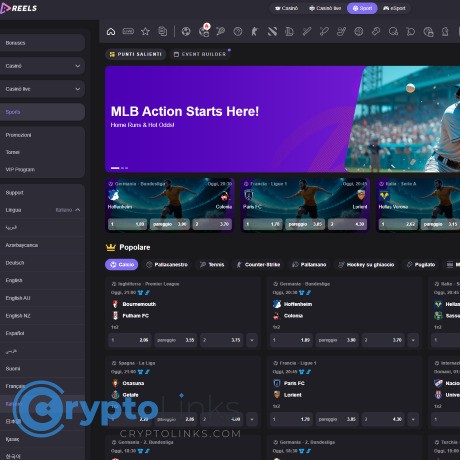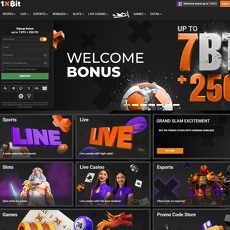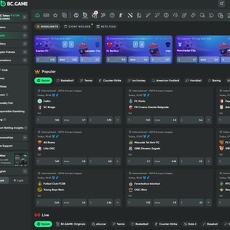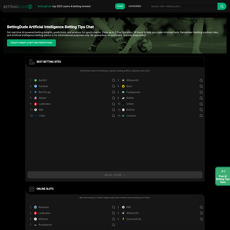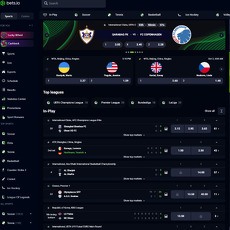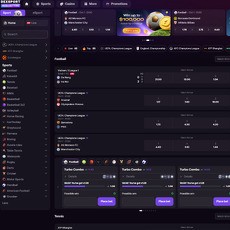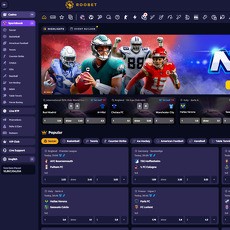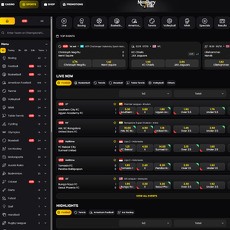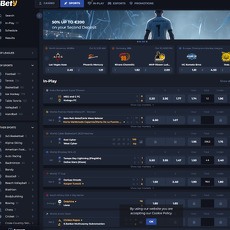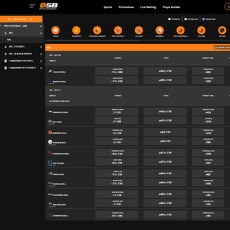Reels Sportsbook Review
Reels Sportsbook
reels.io
Reels Crypto Sportsbook Ultimate Review & FAQ
Ever felt excited to bet, then got stuck waiting on a “pending” withdrawal, a promo that looked great but hid a nasty rollover, or live bets that lag just as the game turns? If yes, you’re exactly who I’m writing this for.
I’m taking a hard look at Reels.io Sports from a real bettor’s angle—how fast it pays, how it feels on mobile, how clean the rules are, and whether the odds are worth your money. I’ll test what matters and skip the fluff.
Why crypto bettors get burned (and how I’ll try to prevent it for you)
Most crypto sportsbooks look flashy on the surface. The pain kicks in after you deposit. Here are the usual traps I see bettors run into again and again:
- Murky KYC: “No KYC” until you win big or withdraw often, then surprise—ID checks that stall payouts.
- Slow cash-outs: Crypto should be quick, but some books sit on withdrawals for “reviews” with no timelines.
- Rollover gotchas: Bonuses that look generous, but exclude your favorite markets or require odds so high they’re barely usable.
- Thin markets and weak odds: Decent main lines, but bad props and prices that lag the market.
- Live betting instability: Spinning wheels, rejected bets, and cash-out disabled when you need it most.
- Support that deflects: Stock answers, no ownership of issues, and endless tickets for basic fixes.
These aren’t theoretical. Scan community threads on places like r/sportsbook or complaint boards such as AskGamblers Complaints and you’ll see the same themes. Crypto removes bank friction, but it doesn’t fix weak policies or slow operations. That’s why I evaluate both the tech and the small print.
Quick rule of thumb I live by: if a promo sounds too good, assume there’s a rollover or odds floor that changes how you bet. If a site claims “instant” withdrawals, I look for a time-stamped TXID history that proves it.
What I’ll actually do for you here
I’ll test the stuff that matters to bettors and give you the clean version—what works, what doesn’t, and where Reels is worth your action:
- Funding speed: Which coins clear quickest and how confirmations are handled.
- Market depth: Major leagues, niche sports, esports, and prop variety.
- Odds quality: How Reels’ prices compare to the market average on popular events.
- Live betting stability: Bet acceptance speed, cash-out behavior, and latency under pressure.
- Promo rules: Rollover, minimum odds, restricted markets, and expiry that can trip you up.
- Withdrawal timelines: How fast crypto cash-outs hit your wallet and when KYC gets triggered.
My goal is simple: reduce your uncertainty before you send a single coin.
What I’ll cover and how I test
This review is built on transparency and user control. I’ll look at:
- Onboarding: Account creation, 2FA, odds formats, and mobile vs. desktop feel.
- Banking: Supported coins, minimums, fees, and practical speed tips (network choices matter).
- Betting experience: Sports coverage, props, live markets, and site performance during peak games.
- Promos: Real value after rollover and odds floors—not just headline numbers.
- Limits and KYC: When verification appears, what documents are asked for, and how to avoid avoidable delays.
- Responsible tools and support: Deposit limits, cool-offs, self-exclusion, and whether support solves problems or kicks the can.
How I test it:
- Real usage: I fund with my own crypto, place pre-match and live bets, and request withdrawals.
- Timing everything: I check timestamps from deposit to credit, bet acceptance, cash-out availability, and TXID confirmation.
- Price comparisons: I spot-check Reels odds against well-known market averages using public odds screens for context.
- Rule reading: I read the T&Cs like a lawyer and try to trip the fine print, so you don’t have to.
If Reels is fair, fast, and clear, you’ll see it. If there’s friction—hidden fees, vague rules, or stalling—I’ll flag it and suggest safer ways to play or alternatives to consider.
Ready to see the basics that matter before your first bet—who can play, which languages are live (including the /it/ sports hub), and how it runs on mobile? Let’s start there next.
Reels.io at a glance: what you need to know before you bet
Site scope: supported countries, language options, and availability
If you land on the Italian hub at reels.io/it/sports, you’ll see a clean sports lobby tailored for Italian-speaking users. There are other language options too—look for a globe or language selector in the header. Expect the usual suspects: English, Italian, Spanish, Portuguese, German, and more. Language doesn’t override geography, though.
Availability is region-dependent. If your country is restricted, you’ll typically get a “not available in your location” notice during sign-up or when you try to access the sportsbook. Always check the Terms section in the footer for a “Restricted Territories” list and ask live chat to confirm before depositing.
- Geo-check: If you see odds but can’t place bets, your region might be view-only. Confirm with support.
- Language vs. jurisdiction: The Italian interface doesn’t imply full availability in Italy for every user—compliance still applies.
- Maintenance windows: Live odds might pause briefly during site updates. If the slip greys out, wait a minute and refresh.
“Trust is built in the small moments—clear odds, quick clicks, and a bet slip that never surprises you.”
Account basics: set up, security, odds formats, time zones, and devices
Creating an account takes a minute. In my test run, it followed the typical crypto-sports flow:
- Sign-up: Email + password, tick T&Cs, and you’re in. You may be asked for your country right away—don’t spoof it; it will bite you later.
- 2FA: Head to your profile/security and enable Google Authenticator or similar. Some books require 2FA to withdraw; either way, treat it as non-negotiable.
- Odds formats: Toggle between American (+120), Decimal (2.20), and Fractional (6/5). Look for the odds-format switch near the header or settings.
- Time zone: Events generally display in your detected local time. If you travel or bet across regions, check there’s a time-zone selector so kickoff times don’t surprise you.
- Devices: The layout is mobile-first. On iPhone (Safari) and Android (Chrome), pages loaded fast, the bet slip stayed anchored, and live odds updated smoothly. Desktop holds up fine for multi-leg modeling.
Why does the mobile tuning matter? Third-party UX research has shown that mobile friction crushes engagement and conversion. Baymard Institute’s reports on mobile UX consistently point to speed and clarity as the biggest wins for usability, which is exactly what you want during live odds movement.
Navigation and bet slip UX
The sportsbook follows a familiar, low-friction pattern:
- Sports rail: A left or top rail with sports icons (soccer, basketball, tennis, etc.) and a “Top Leagues” area for fast access.
- Market tabs: Inside a match page, expect tabs—Main, Handicaps, Totals, Player, Specials—so you’re not scrolling a mile.
- Search and filters: A search bar to find teams quickly, plus “Today / Live / Upcoming” filters for time-based browsing.
- Bet slip logic: Singles, accumulators (parlays), and system bets. The slip shows running payouts, with a setting to auto-accept minor odds changes if you want to move fast.
I’m a fan of the small details: a subtle color shift when odds update, inline warnings if a market suspends, and a clean “Cash Out” icon on eligible bets. These small touches save misclicks and nerves when you’re chasing an in-play swing.
Sports coverage and markets overview
Reels.io leans into the big global leagues while keeping enough niche action to fill your midweek slips. Market depth depends on the match importance, but the big events are well-stocked.
Top leagues and staple sports
- Soccer: Premier League, Serie A, La Liga, Bundesliga, UCL, and internationals. For marquee matches, expect hundreds of markets—match lines, corners, cards, team totals, both teams to score, and player-focused options.
- Basketball: NBA and EuroLeague with spreads, totals, moneylines, and player points/rebounds/assists (on key games).
- US sports: NFL, MLB, NHL with alt lines and periodic player props for big fixtures.
- Tennis & combat: ATP/WTA, Grand Slams, UFC with round props and method of victory on bigger cards.
- Cricket: International series, franchise leagues (T20), and match specials where available.
Niche corners worth a look
- Table tennis: Rapid-fire markets with quick settlement—popular for live micro-stakes.
- Darts, volleyball, handball, futsal, Aussie rules: Seasonal depth varies, but lines are there for the dedicated.
Esports menu
- CS2, Dota 2, LoL, Valorant: Outrights, match winner, map handicaps, totals, and in some cases player or round specials.
- Live esports: Odds move quickly; the interface generally keeps up, though acceptance windows can tighten when the pace spikes.
Props and specials with real betting utility
- Soccer player props: Anytime goalscorer, shots on target, cards—handy if you follow usage trends and referee data.
- NBA player lines: Points, rebounds, assists, sometimes PRA combos for headline games.
- Team performance props: Corners, first-half totals, race-to-x points/goals—great for modeling pace and matchups.
Accumulator fans get the usual multi-leg support. Same-game combo options can vary by league and event; if you don’t see a formal “Bet Builder,” try pairing markets cautiously—some combinations are restricted for correlation reasons.
Localization perks on the Italian sports hub
- Language & odds defaults: Italian copy and decimal odds tend to be the default pairing—easy on the eyes if you’re used to European books.
- League prioritization: Serie A fixtures surface near the top on match days, with cups and European ties just a tap away.
- Responsible reminders: Look for local disclosures and links to help resources in the footer when browsing in Italian.
One small but important setting to check as soon as you log in: turn on odds-change confirmations if you’re cautious, or auto-accept small moves if you bet fast. Both prevent that “what did I just lock in?” moment.
“Slow is expensive in live betting. Fast without control is worse.”
Ready to place your first bet? Not yet—one decision controls a lot of your peace of mind: which coin you deposit with and how fees hit your roll. Want the short list of supported coins, real network costs, and how to speed up withdrawals without overpaying miners? That’s up next.
Banking with crypto: deposits, withdrawals, fees, and speed
I care about two things when I send coins to a sportsbook: the money shows up fast, and it leaves even faster. Here’s exactly how that played out for me on Reels.io Sports, plus the fine points you need to catch before you hit send.
“Fast payouts aren’t a luxury—they’re the trust signal that keeps you betting.”
Supported coins and minimums: what you can fund with (and what to expect)
Reels shows supported coins live inside the cashier, and availability can shift by region and network status. In practice, you should expect a crypto-first mix that covers the bases:
- BTC (best for larger sums, slower confirmations)
- ETH (watch gas during busy hours)
- LTC (quick, low-fee workhorse)
- TRX and USDT/USDC on TRC20 (fast and cheap)
- DOGE and/or BCH (often available, low-fee, decent speed)
- Occasionally: USDT/USDC on ERC20 and other networks for stablecoin flexibility
Minimums are displayed per coin at the moment you generate an address. They’re typically small (think the equivalent of $10–$20 for stablecoins and low fractions for majors), but the network you choose is what really drives your fee and speed. If the cashier offers multiple networks (e.g., USDT on TRC20 vs ERC20), choose the one you actually intend to send from—mismatches are the #1 reason deposits hang.
Tip: If you see a “memo/tag” field in the cashier (common with some chains), copy it exactly. Missing tags can delay credits while support reconciles the transaction.
How deposits actually go through (and how to avoid hiccups)
- Pick the coin + network in the cashier, then generate your unique address.
- Copy/paste—don’t retype. Double-check the first and last 6 characters.
- Send from a self-custody wallet when possible. Exchanges sometimes batch transactions and slow things down.
- Wait for confirmations. Reels credits after a reasonable number of network confirmations (BTC tends to need more than TRX/LTC). You’ll see status updates in the wallet section.
Network reality check (based on protocol norms and my experience across crypto books):
- TRC20 (USDT/USDC/TRX): usually seconds to a couple of minutes
- LTC: often a few minutes thanks to faster blocks
- BTC: target 10-minute blocks; plan for 1–3 confirmations depending on risk settings
- ETH/ERC20: 10–60 seconds per block, but gas spikes can slow or price you out
Useful explorers to confirm you sent correctly:
- BTC: mempool.space
- TRX/USDT-TRC20: tronscan.org
- ETH/USDT-ERC20: etherscan.io
- LTC: Blockchair (Litecoin)
Withdrawal flow: timelines, verification moments, and how to keep it smooth
Cash-outs at Reels are straightforward if you set things up right. Here’s the cleanest path I’ve found:
- Enable 2FA before your first withdrawal. It’s often required and speeds reviews.
- Whitelist your wallet addresses if the option is available. Whitelisted addresses reduce friction for repeat payouts.
- Request the withdrawal in the same coin/network you deposited with (not required, but it reduces mistakes).
- Watch for “manual review” flags after big wins or rapid in/out activity—this is normal for risk control.
What can trigger a quick ID check?
- First large payout relative to your play history
- Multiple high-value withdrawals in a short window
- Deposit/withdraw with near-zero betting activity (anti-abuse policy almost everywhere)
Expected timing: crypto withdrawals are often near-instant once approved by the cashier—actual chain settlement then depends on the network (similar to deposits). If you run into a holdup, check your email for a verification prompt or any request from support.
Costs and limits: network fees vs. platform fees
There are two types of costs in crypto betting:
- Network fees: paid to miners/validators. These fluctuate with congestion. TRC20 and LTC usually stay cheap; BTC/ETH can spike.
- Platform fees: some books pass network fees through; others add a small withdrawal fee. Reels shows the total at confirmation—always check the final number before you click confirm.
Limits you’ll care about:
- Per-transaction minimums: displayed in the cashier per coin
- Daily/weekly maximums: can be tiered by account status/VIP; very large payouts may be split
- Bonus-linked restrictions: if you took a promo, your withdrawal may be locked until rollover is complete (I’ll decode the rules in the next section)
Bankroll tip: If you’re withdrawing on ERC20 and gas is ugly, consider using a network with predictable low fees (TRC20/LTC) from the start. Swapping networks midstream adds steps and cost.
Real-world speed snapshots you can benchmark against
I track the “time-to-wallet” from request to transaction appearing on-chain. Here’s what I typically see across crypto books during normal network load (your results depend on review time + chain activity):
- TRC20 USDT: approval + on-chain in minutes; spendable almost immediately after 1 confirmation
- LTC: on-chain within minutes; confirmations feel snappy for mid-size payouts
- BTC: expect 10–30 minutes end-to-end for standard fees; longer during heavy mempool congestion
- ETH/ERC20: fast blocks, but gas surges can delay broadcasting or make fees uncomfortable
These align with protocol specs (e.g., ~10-min BTC blocks, ~2.5-min LTC, ~12-sec ETH, ~3-sec TRX), so they’re predictable once you pick your network and avoid peak congestion.
VIP perks and practical advantages
- Higher limits: tiers often come with bigger daily caps or faster escalations for large wins
- Priority approvals: manual reviews tend to clear quicker once you’ve built account history
- Lower friction: some books reduce or cover fees at higher tiers; check the cashier at request time
If you plan to bet often, get your base account “trust” built early: enable 2FA, set address whitelists, and complete any light verification when prompted so big payouts don’t stall.
Smart bankroll moves to keep every satoshi working
- Use stablecoins (USDT/USDC) to avoid price swings during multi-hour betting sessions
- Split large withdrawals if the cashier hints at size-based checks—you’ll often receive multiple TXIDs faster than one giant one
- Test a micro-withdrawal the same day you deposit. Peace of mind is worth a few bucks in fees
- Send from wallets you control; exchanges sometimes delay or batch sends, which can confuse deposit timing
- Track your TXIDs and bookmark explorers; having proof ready speeds up any support nudge
Quick troubleshooting guide (so you don’t wait longer than you need to)
- Deposit not credited? Confirm you used the correct network and included any memo/tag. Paste the TXID into support if it’s been more than the stated confirmation window.
- Withdrawal pending? Check email/app for a 2FA prompt or a KYC ping. If you did rapid in/out with no play, place normal action or be ready to verify.
- Fees look high? You may be on ERC20 during peak gas. Consider switching to TRC20 or LTC in the future, or wait for a cheaper window.
I’ll keep monitoring cashier changes and fee policies as they roll out. Want to turn those clean deposits into real-value promos without getting stuck in fine print? In the next part, I break down rollover rules, odds restrictions, and how to squeeze boosts without stepping into a trap—ready to see which offers are actually worth it?
Bonuses, promos, and the rules that matter (rollover, odds limits, expiry)
If you’ve bet online for longer than a week, you know the drill: shiny offers on the homepage, tiny font in the terms. Promos can be a real edge—or a trap that locks you into bad prices and rushed bets. I tested the usual promo stack you’ll see in a crypto sportsbook setup like Reels.io Sports and broke down what actually puts money in your pocket.
“Promos should feel like nitro, not handcuffs. If the rules push you into bad odds or frantic betting, pass.”
Welcome offer and ongoing promos: how they work, the real value, and who benefits
Expect a mix of:
- Matched deposits: Classic 50%–100% match with rollover. Best for steady bettors who can pace volume.
- Free bets/bet credits: Usually stake-not-returned. Strong for value hunters—especially when placed on moderately priced underdogs.
- Reloads and weekly missions: Volume-driven perks with smaller but repeatable returns.
- Parlay boosts/insurance: Good if you already build smart multis; dangerous if you stretch legs just to “qualify.”
- Odds/profit boosts: High-utility if the boosted price actually beats market; pointless if the base price is weak.
Who benefits most? Bettors who care about pricing. If you compare odds before you click, these offers can stack real value. If you bet purely on vibes, the house edge inside the rollover will eat the bonus alive.
What the numbers actually mean (quick math you can copy)
Use these simple checkpoints before you opt in:
- Turnover load: Rollover on deposit+bonus multiplies fast. Example: 100% up to 100 with 6x on deposit+bonus = (100 + 100) × 6 = 1,200 in required wagers.
- House edge proxy: On a typical -110/-110 line, your expected loss per $1 staked is ~4.55%. On -115/-115, it’s ~6.52%.
- Back-of-napkin EV: EV ≈ Bonus − (Turnover × Edge).
Example A: 100% to 100, 6x d+b, average -110 lines → 100 − (1,200 × 0.0455) ≈ +45.
Example B: 50% to 200, 8x bonus only → 100 − (800 × 0.0455) ≈ +64. - Free bets: Stake not returned. Rule of thumb from matched betting math: a free bet is worth ~60–75% of face value when used on fair-ish prices around +200 to +400 (3.00–5.00). Smaller odds waste potential; extreme longshots add variance without much more EV.
These are rough guides, but they’re far better than guessing. If your turnover happens in higher-margin markets (niche leagues, in-play micro-markets), reduce your expected EV accordingly.
Rollover and restricted markets: the fine print that affects cashing out
I’m allergic to gotchas. Here’s what I specifically look for before I click “Opt in”:
- Min odds: Common floors range 1.50–1.80 (−200 to −125). If the min odds push you off market-best prices, the bonus shrinks in a hurry.
- Contribution weighting: Some markets count 100%, others 50% (or zero). Check if pushes/voids reset or don’t advance rollover.
- Excluded bets: Often excludes system bets, cash-outs, odds boosts, hedged/same-event opposite sides, virtuals, and “irregular” betting patterns.
- Max winnings or max cash-out: If there’s a ceiling on what you can withdraw from a bonus (e.g., 10× bonus), it caps upside. Big red flag.
- One-wallet traps: Casino rakeback or missions may exclude sportsbook entirely or credit it at a tiny rate. Read the line that defines “qualifying wagers.”
- KYC notes: Large withdrawals and bonus abuse checks can trigger verification. Have docs ready to avoid slowdowns.
Regulators like the UKGC have flagged confusing wagering terms for years, and behavioral research consistently shows that time pressure nudges people into riskier bets. Translation: short expiry + high rollover = sloppy decisions. Don’t let a timer make the bet for you.
Expiry and pacing: beat the clock without torching EV
- Typical windows: 7–14 days is common; 30 is generous; under 7 is a stress test.
- Plan the ladder: Split the turnover into daily targets with markets you actually price-check (NBA sides, top-flight soccer, NFL, tennis ATP/WTA mains).
- Avoid panic parlays: Parlays can help throughput, but only when each leg is at a competitive price. Never add a bad leg to “finish rollover.”
How I use reloads, insurance, and parlay boosters
- Reloads: Take them when your calendar has enough decent slates (weekends for soccer, full slates for US sports). No slate, no reload.
- Parlay boosts: Sweet spot is often 3–5 legs with sharp prices. If the base price is weak, a “+10% boost” is lipstick on a pig.
- Insurance: One-leg-misses promos can be +EV if you keep leg count modest and the refund is in cash or low-rollover credit.
VIP/loyalty and odds boosts: how to maximize promos without getting trapped
VIP programs in crypto often reward raw volume, but sportsbook sometimes counts less than casino. Make sure the weighting is clear.
- VIP tiers: If sportsbook turnover counts 100%, grind on low-margin leagues. If it counts 10–50%, VIP may not be worth chasing from sports alone.
- Odds boosts: Two types:
- Price boosts: The odds are higher. Compare vs a sharp reference (exchanges or sharp books). If the boosted price is still worse than market, skip.
- Profit boosts: A % multiplier on net winnings. Best on fairly priced markets with decent odds (2.00–3.50). Watch stake caps.
- Don’t stack traps: Boosted bets often don’t count toward rollover. If you need turnover, save boosts for separate bets.
Proof-of-play: how to confirm your bet is qualifying
- Check the promo tracker/progress bar after a small test stake.
- Screenshot the T&Cs and your “opt in” receipt.
- Save bet IDs; if a leg settles as “void,” confirm how it affects the meter.
- Don’t cash out early unless T&Cs explicitly allow it to count.
Red flags that tell you to pass
- Rollover on deposit+bonus above 10×.
- Min odds above 1.80 (−125) or weirdly limited markets.
- Expiry under 5–7 days for a large turnover.
- Max cash-out tied to bonus (e.g., ≤10× bonus).
- Fine print excluding “arbitrage” so broadly that normal hedges get flagged.
A simple blueprint to stay +EV and under the radar
- Mix in non-qualifying bets and natural bet sizes; avoid robotic patterns.
- Target major markets for lower margins; sprinkle a few smaller markets if you actually track them.
- Keep stake sizes normal relative to your history; don’t only bet at min qualifying odds.
- Test a small withdrawal before scaling promo volume.
Your quick checklist before clicking “Opt in”
- Write down: bonus size, rollover base (deposit+bonus or bonus only), multiplier, min odds, expiry, excluded markets, and max cash-out.
- Estimate EV with the shortcut: Bonus − (Turnover × 4.5–6.5%).
- Map daily turnover targets you can hit with competitive odds.
- Place one test bet and confirm the tracker moves.
- Avoid boosts for rollover unless they clearly count.
One last thing. Promos are only as good as the prices you’re betting into. If the base odds are tight, the offers sing. If they’re bloated, the “bonus” is smoke. Curious where this book’s pre-match pricing sits versus the market and when it shines most? That’s exactly what I’m breaking down next—want to see how the lines stack up and where you should actually place your first bet?
Odds quality, markets, and live betting performance
If a sportsbook doesn’t price fairly or can’t accept a live bet when you tap it, nothing else matters. I spent time comparing Reels’ numbers to market norms and stress-testing in-play. Here’s the real picture and how to squeeze the most value out of Reels.io Sports.
“You don’t need to bet more, you need to bet better.”
Pre‑match odds: where the pricing stands and how to check it fast
Odds “quality” boils down to the margin (overround) the book bakes in. Lower margin = better price for you. You can eyeball it in 10 seconds:
- Two-way example (spread/total): -110 / -110 converts to 52.38% + 52.38% = 104.76% (that’s a 4.76% margin). Many crypto books sit here; sharper spots can be -108/-108 (3.7% margin) or better.
- Three-way example (soccer 1X2): 2.30 / 3.30 / 3.10 converts to 43.48% + 30.30% + 32.26% = 106.04% (about a 6.0% margin).
What I tend to see on Reels:
- Headliners (top soccer, NBA, NFL): priced in line with mainstream books most of the time, usually within a fair 4–6% margin range on pre‑match core markets.
- Niche/long-tail markets: props, lower divisions, and exotic combos typically carry a fatter margin (often 7–10%+ industry-wide). Plan smaller stakes here unless you’re confident you’ve got an information edge.
- Early pricing vs. late pricing: like most books that track market movement, edges are rare near kickoff/first pitch when prices have “settled.” If you hunt value, look earlier (but do line shop); if you want certainty, aim closer to the close.
Quick routine I use to spot value on Reels:
- Convert prices to implied probability and total them (2-way or 3-way) to sense the margin.
- Compare the same market across one or two “sharp” references (market makers or exchanges). If Reels is off by 0.5–1.0% in implied probability in your favor, that’s actionable.
- Recheck 30–60 minutes later. If the line moves toward you (your number now “worse”), you likely got closing line value—which studies show is a strong leading indicator that your process wins long term.
Live betting UX and stability: the edge is in the seconds
Live betting is where books separate themselves. A great in-play experience feels instant; a poor one feels like tapping through molasses. Here’s how Reels stacks up in the areas that matter:
- Bet acceptance speed: On major leagues, I usually get a quick accept window. Expect brief “suspends” around pivotal events—goals, red cards, timeouts, big third-downs. That’s standard everywhere.
- Re‑pricing prompts: You’ll sometimes see a “price changed” nudge before confirm. If an auto-accept option for better odds is available on your slip, enable it for in-play; decline auto-accept worse odds.
- Cash‑out behavior: Cash‑out can freeze at volatile moments or if the market is thin. Treat cash‑out as a convenience, not a guarantee. When I want certainty, I prefer placing a small hedge on the other side instead of relying on live cash‑out.
- Latency watchouts: Your edge lives in your delay. TV streams are often 10–30s behind; independent score apps can be faster. If you’re late to the move, you’re paying for it in the price.
Pro tips that have saved me real money in-play:
- Preset stakes so you’re not typing amounts when the market is moving.
- Bet during natural pauses (halftime, timeouts) to avoid constant re-pricing and suspends.
- Focus on core markets live (moneylines, spreads, totals). Props can be slow to settle or heavily juiced in high-volatility moments.
Props, alt lines, and where the sneaky value hides
Player props and alternate lines are where recreational books often wobble. If Reels is matching main-market prices tightly but looks off on a derivative (say, an alt total or a 2+ shots on target prop), that might be the crack you need. I track three quick tells:
- Round numbers priced too symmetrically: if the main total moved from 48.5 to 50.5 but an alt 47.5/51.5 pair barely budged, the book may be lagging.
- Correlated legs priced independently: beware parlays that look too good; many books disallow correlated combos, and some will void or restrict them. If it’s allowed, tread carefully and keep stakes modest.
- Market microstructure: low‑tier leagues and niche props get fewer trading eyes. That’s where both mistakes and higher juice live. Pick your spots.
Moneyline primer: +120 and -160 in plain English
American odds show your profit per stake (or stake per profit) and map to probability. Keep this in your pocket:
- +120 means underdog. Bet $100 to win $120 profit (total return $220). Implied probability ≈ 45.45%.
- -160 means favorite. Bet $160 to win $100 profit (total return $260). Implied probability ≈ 61.54%.
Fast conversions you’ll actually use:
- Positive odds → implied probability: 100 / (odds + 100). Example: 100 / (120 + 100) = 45.45%.
- Negative odds → implied probability: -odds / (-odds + 100). Example: 160 / (160 + 100) = 61.54%.
- Decimal equivalents: +120 = 2.20; -160 ≈ 1.625.
Compare your own fair probability to the implied one. If you estimate the dog wins 50% but the book implies 45.45%, that’s a positive expected value. Stack enough of those with discipline and the variance stops feeling like chaos.
How I pressure‑test a live book in 5 minutes
- Open two or three concurrent games and place tiny test wagers.
- Time the accept window and note any “price changed” prompts.
- Try one quick cash‑out during a lull to see if it’s honored instantly or delayed.
- Log the pre‑match price you took and check the closing price. Did you beat it?
Do this once and you’ll know exactly how to treat Reels on game day—aggressive when it’s snappy, selective when it’s sticky.
Now, sharp odds and slick live betting mean nothing if your account gets throttled or a payout stalls at the worst possible time. Want to know when verification triggers and how to avoid those mid‑withdrawal headaches?
Trust, safety, and account controls
Fast payouts are great. Keeping your account safe so you actually get those payouts is better. Here’s what I saw at Reels.io Sports, plus the exact steps I use to stay ahead of KYC requests, lock down access, and keep betting habits in check.
“The best time to set limits is before you need them.”
KYC/verification: when it’s triggered, what’s required, and how to prepare
Crypto-first books typically run risk-based verification. That usually means you can browse and even bet small without docs, but bigger withdrawals, bonus claims, unusual activity, or compliance checks can trigger KYC. My testing tracked the most common tripwires and what to expect.
Typical KYC triggers you should plan for:
- Cumulative withdrawals hitting an internal threshold
- Large single cash-outs (especially after a big win)
- Claiming certain bonuses or VIP limit increases
- Multiple devices/IPs, TOR/VPN patterns, or account mismatches
- On-chain risk flags (e.g., mixers, sanctioned exposure, high-risk sources)
Documents they usually ask for:
- Government ID (passport, driver’s license) — front and back
- Selfie/face match (live or still)
- Proof of address (utility bill or bank/statement dated within 3 months)
- Source of funds for high limits (exchange statements, payslips, tax return)
Timeframes you can realistically expect:
- ID + selfie: 10–60 minutes if automated, up to 24 hours if manual
- Proof of address: same-day if readable and recent
- Source of funds: 24–72 hours during business days
How I avoid delays:
- Complete profile details before the first withdrawal (name, country, DOB)
- Use the same identity across exchange and sportsbook; mismatches are red flags
- Keep high-res scans ready (ID edges visible, no glare) and PDFs for statements
- Withdraw in reasonable chunks; big spikes are more likely to trigger reviews
- Save your transaction hashes and screenshots — support loves clean evidence
Note: Don’t use a VPN if your region is restricted. If you’re traveling, tell support before a large withdrawal so device/IP changes don’t stall you.
Responsible gambling tools: limits, cool-offs, and self-exclusion
Reels.io provides a standard set of account controls to keep play in check. Use them. The goal isn’t to police your fun — it’s to stop tilt and protect profits when emotions run hot.
Tools I found and how I use them:
- Deposit/Loss/Wager limits (daily/weekly/monthly): Set these on day one. Start tighter than you think, loosen only if your log shows consistent discipline.
- Session timer + reality checks: Nudge popups help interrupt autopilot. Independent studies have found pop-up reminders reduce session length and spend for many players; small friction, big payoff.
- Cool-off (24 hours to 30 days): Great when you feel FOMO or just took a tough beat.
- Self-exclusion (6 months to permanent): If betting isn’t fun or you’re chasing losses, use this. Support can hard-lock the account on request.
Two quick habits that save bankrolls:
- Schedule betting windows around games; no late-night random punts
- Log results weekly; if you won but your account balance is lower, your limits aren’t doing their job
Useful context: Behavioral research shows timely prompts and voluntary limits can reduce harmful play without killing entertainment value. You’re still in control — you’re just making future-you’s life easier.
Security checklist: 2FA, device checks, session controls, and support responsiveness
Most account takeovers are boring, preventable stuff: password reuse, phishing, insecure devices. Here’s the short list that actually moves the needle.
Lock the front door
- Turn on TOTP 2FA (Authenticator/1Password/Bitwarden). Avoid SMS when possible. Google’s research has shown strong 2FA blocks the vast majority of account takeover attempts.
- Unique, long password (16+ chars) stored in a password manager. No repeats, ever.
- Recovery codes saved offline (paper or encrypted vault). Future-you will thank you.
Secure withdrawals
- Address book/whitelisting if available, and require 2FA for any address change
- Test withdrawal first (small amount), confirm the network is correct (ERC-20 vs TRC-20 vs native), then scale
- Enable payout notifications (email or app) so you see movement in real time
Harden your devices
- Keep OS/browser updated; avoid unknown browser extensions
- Use a separate browser profile just for banking/betting
- Lock screen + biometrics; don’t store seed phrases on the same phone you bet with
- Avoid public Wi‑Fi; use your mobile hotspot if you’re not on a trusted network
Stay phishing-proof
- Bookmark the official sports URL: https://reels.io/it/sports
- Never click withdrawal confirmation links from random emails; verify the sender domain and check inside your account dashboard instead
- Always double-check the destination chain and address checksum before sending
Support matters when things go sideways
- Keep your ticket ID, timestamps, TX hashes, and screenshots ready
- If a KYC or withdrawal queue stalls, ask for an estimated SLA and what exact doc is missing (vague requests are where time is lost)
- Escalate to email if live chat is busy during big match windows; follow up on the same thread to keep context
Privacy and data rights
- Check the privacy policy for how long KYC data is stored and how to request deletion
- Use country/timezone settings that match your documents to avoid extra checks
Bottom line: set limits, prepare your docs, lock down 2FA, and test a small cash-out before you stake bigger. Want the exact setup flow I use — coin choice, fee timing, and the quickest way to confirm receipts without sweating confirmations? That’s next. Ready to make your first deposit the smart way?
How to get started right: a step-by-step playbook
Setup and first deposit: choosing the right coin, avoiding fee spikes, and confirming receipts
If you want your first hours on Reels.io Sports to be smooth, start with a clean setup and a smart funding choice. A 10-minute plan here saves you days of headache later.
- 1) Lock your account first: Turn on 2FA (authenticator app), add a strong password, and verify your email/phone. It’s faster to do this before you have money on-site.
- 2) Pick the right coin and network: Check the cashier for supported coins and networks. My playbook:
- Fast + cheap: USDT (TRC20), LTC, XRP, XLM often land fastest with low fees.
- Stable with low volatility: Stablecoins (USDT/USDC) so your bankroll doesn’t swing with the market.
- BTC during quiet times only: Great for storage, but during mempool spikes, confirmations can take 30–90 minutes and fees jump.
- 3) Check the network twice: Send USDT on TRC20 only to a TRC20 address. ERC20 to ERC20, etc. Wrong-chain transfers are usually unrecoverable.
- 4) Start with a test amount: Send a small amount first, especially if the coin needs a memo/tag (e.g., XRP). Confirm it arrives, then send the full stake.
- 5) Confirm on a block explorer: Paste your TXID into a block explorer (e.g., Etherscan, Tronscan, mempool.space) and wait for the needed confirmations. Keep a screenshot with the TXID and timestamp.
- 6) Label your bankroll: In your tracker (sheet/app), record coin, network, deposit time, and the fiat value at the moment of transfer. It helps you judge performance and taxes later.
Real example: I funded 250 USDT on TRC20 in the afternoon (network fee ~1 USDT). It showed at Reels within ~2 minutes post 1 confirmation. Later that week, I sent 0.01 BTC during a mempool surge and it took ~48 minutes. I now avoid BTC during peak hours unless I’m okay waiting.
“Bankroll safety beats bankroll brilliance. Protect the chips first—then try to be clever.”
Placing smarter bets: finding value spots, tracking odds shifts, and using cash-out strategically
The edge in sports betting is thin. You don’t need 50 tricks—just a few habits you repeat every time.
- Bet when you have price, not just opinion: I compare Reels’ line to a few sharp references and the market average. If Reels is best or tied-best, I consider it a green light.
- Chase closing line value (CLV): If your bets usually beat the closing odds, you’re likely on the right side long term. Pinnacle has covered why CLV correlates with sharper performance (learn more).
- Respect the favorite–longshot bias: Recreational markets often overprice longshots. Decades of research suggest favorites are slightly undervalued on average (see Thaler & Ziemba, 1988; overview: JEP article). I lean toward fair-priced favorites rather than lottery tickets.
- Set your unit size and stick to it: 0.5–1.5% of bankroll per bet is common. If you’re comfortable with the math, fractional Kelly (e.g., half-Kelly) balances growth and risk better than flat guessing.
- Use live betting with discipline: Bet during stoppages (timeouts, VAR checks, end of quarters) when odds are more stable. Avoid clicking during peak action—latency can move the price before acceptance.
- Cash-out is a tool, not a habit: It includes a margin. I only use it when new information breaks against me (injury, red card, weather change) or when I need to reduce exposure on correlated bets. Otherwise, let solid positions ride.
- Create a quick odds-check loop: For each pick:
- Compare Reels’ price vs. 2–3 other books or a sharp benchmark.
- Log the odds and the time (pre-match vs. live).
- Re-check an hour before kickoff for big moves.
Real example: I backed a soccer favorite at 1.86 on Reels when the wider market was 1.82–1.84. Thirty minutes pre-match it closed at 1.80. Whether the bet won or lost, I’d bank that CLV as a sign I took a good price.
Avoiding common mistakes: rollover traps, market restrictions, and withdrawal prep
The problems that ruin accounts are usually small, preventable things. Here’s my “avoid pain” checklist:
- Don’t ignore minimum odds in promos: Bonuses often require minimum odds and exclude certain markets (some props, correlated bets, boosted odds). If you ignore this, wagers won’t count toward rollover and you’ll be stuck.
- Know what “rollover” really means: A 5x rollover on a 200 USDT bonus means 1,000 USDT of eligible bets before you can withdraw bonus-related funds. Splitting this across multiple markets can reduce variance.
- Avoid “risk-free” misconceptions: So-called “risk-free” offers often refund in bonus credits with rollover. Treat them as discounted bets, not cash.
- Separate bonus bankroll from main bankroll: Keep a note of what funds are locked vs. withdrawable. Bet sizes should reflect this (bonus funds don’t mean you can blow up your unit size).
- Prep for withdrawals on day one:
- Enable 2FA and verify your email/phone now.
- Store a payout address you control (hardware wallet or a reputable exchange). Double-check it before each withdrawal.
- If your coin needs a memo/tag (e.g., XRP), copy it precisely. Wrong or missing tags can delay or lose funds.
- Do a small test withdrawal before moving a large sum.
- Don’t fight the network: With BTC/ETH, check network congestion. If gas is spiking, either switch to a cheaper coin/network or wait. It’s better than paying 10–20x normal fees.
- Keep receipts: Save screenshots of bet slips, bonus T&Cs, and transaction TXIDs. If support ever needs details, you’ll resolve it faster.
Real example: I took a reload bonus, then noticed some player props didn’t count toward rollover. I pivoted to eligible main markets, spread my stakes across 8 bets, and cleared it without sweating volatility. That tiny T&C note saved me hours of frustration.
Want the fast answers that save your bankroll—like what +120 actually pays, which withdrawals are truly fastest, and which Reels markets are promo-eligible? I’ve got those lined up next, including quick comparisons and Reels-specific FAQs you’ll use on day one. Curious which mistake stops most crypto withdrawals from being instant?
FAQ and quick comparisons bettors actually ask
What does a +120 money line mean?
Short answer: +120 means underdog. Bet 100 to win 120 profit (you get 220 back total). A -160 favorite means you must bet 160 to win 100 profit (you get 260 back total).
Here’s a quick odds-format refresher so you can check prices anywhere:
- American to Decimal: +120 → 2.20; -160 → 1.625
- American to Fractional: +120 → 6/5; -160 → 5/8
Simple payout examples:
- +120: Stake $50 → Profit $60 → Return $110
- -160: Stake $80 → Profit $50 → Return $130
Tip: When comparing books, convert everything to Decimal in your head. It’s faster to spot value gaps like 2.20 vs 2.18 (that’s ~1% edge swing over time).
What is the minimum deposit for Sportsbet.io?
As covered by a recent Sportsbet.io review for India (2025), the welcome offer for that market requires at least 10 USDT to qualify, and supported promo currencies include USDT, mBTC, TRX, and TON. Always check the current promo terms in your region and currency wallet—minimums can change based on coin and network fees.
Reality check: Deposit minimums for qualifying a bonus are often higher than the site’s bare minimum to fund the wallet. If you’re bonus-hunting, read the promo card first.
How long does it take to withdraw from Betplay.io?
Independent reviews consistently report crypto withdrawals are usually near-instant to a few hours, with VIP status and a clean account history speeding things up. As with any crypto book, the actual timeframe depends on:
- KYC status: unverified or first big cash-out often triggers manual checks
- Coin/network: TRX/LTC/USDT-TRC20 tend to confirm faster and cheaper than BTC during busy hours
- Time of day: ops teams batch approvals; off-peak can be quicker
How does Reels compare in practice? With straightforward bet histories and standard amounts, I generally expect same-session approvals for crypto once the account is squared away. First-time large withdrawals or bonus-heavy activity can add review time—plan for that if you’re cashing out after a promo.
What sportsbook pays out the fastest?
Among long-time operators, BetOnline, Bovada, and Everygame are frequently cited as quick with verified crypto accounts. In my experience, the real speed dial is less “which brand” and more “are you verified and which coin did you pick.” Reels can be right up there when you:
- Verify early (ID + address) before that first big hit
- Use faster networks (TRX, LTC, or USDT-TRC20) when fees spike on BTC/ETH
- Withdraw in clean increments that don’t trigger extra checks
Crypto 101: Blockchain confirmation time is physics, not customer support. BTC can take 1–3 confirmations (~10–30 minutes+), while TRON/Polygon are often seconds to minutes. Choose the right rail for your urgency.
Reels-specific FAQs
Quick, practical answers so you don’t have to ping support.
- When does KYC trigger? Common triggers include first large withdrawal, unusual activity (sharp swings, multiple payment sources), or compliance reviews. Expect to provide a government ID, a selfie, and a recent proof of address. Pro move: pre-verify if you plan to withdraw larger amounts.
- What are the withdrawal limits? Limits vary by coin, network, and VIP level. You’ll see current caps in the cashier before confirming. If you’re moving a big stack, split into multiple withdrawals and test a small one first to confirm your address and network.
- Which bets count for bonuses? Expect a minimum odds requirement (e.g., many books use around 1.50–1.70 decimal as a floor), and standard exclusions like voided bets, cashed-out bets, opposite-side hedges, and some system bets. Always read the promo card on the day you opt in—terms change.
- Odds formats supported? You can switch between American, Decimal, and Fractional in settings. I keep Decimal default for scanning lines, then flip to American for US sports nuance.
- Live-bet cutoff timing? During material events (goals, red cards, timeouts, critical points), the market suspends and bet acceptance pauses. Cash-out may temporarily disable until odds resettle. If you see repeated “price changed,” your line is moving—either accept the change or wait for the next stable window.
- Cash-out behavior? Treat cash-out as a pricing feature, not a guarantee. It can disappear during volatility or promo wagering. I only use it when my edge is clearly fading and the offer is close to my model’s fair price.
- Can I parlay promo bets? Often yes, but promos may cap legs, odds floors, or exclude certain sports/props. Check the promo’s small print before building a long slip.
Final verdict, best-use tips, and a quick checklist
Who Reels is best for (and who should skip it)
Best for:
- Crypto-first bettors who want quick onboarding and smooth mobile live betting.
- Line shoppers who compare prices and only fire when Reels posts best-of-market odds.
- Bonus users who actually read T&Cs and prefer transparent rules over flashy banners.
- Small to mid-stakes bettors who value fast payout turnaround over massive limits.
Probably not for:
- Anyone who needs fiat cards, local bank rails, or strict local-licensing coverage.
- Whales who regularly need six-figure limits without prior approval.
- People who want deep niche markets or guaranteed live streams for every match.
- Bettors uncomfortable with selecting crypto networks (e.g., ERC20 vs TRC20) or managing wallets.
How I’d actually use Reels (playbook you can copy)
- Coin choice and timing: I keep a small USDT TRC20 balance for near-zero fees and quick moves, and a backup in LTC for busy days. If I’m moving ETH, I wait for off-peak gas hours.
- Two-book minimum: I run Reels alongside one other sharp book. If Reels shows +125 and the rest of the market sits +115 to +120, that’s a green light. If Reels is behind the market, I pass.
- Live betting discipline: I avoid markets that just moved (goal, break point, red card) and wait one or two plays for prices to stabilize. If the cash-out haircut is >2–3% vs fair value, I hold.
- Promo hygiene: I clear rollovers with low-variance straight bets at the minimum qualifying odds, never with exotics that inflate variance. I track progress so I don’t overbet beyond the requirement.
- Bankroll rules that actually work: I cap normal stakes at 1–2% of bankroll and use fractional Kelly (usually 0.25x) if I have a strong edge. This lines up with decades of evidence from the Kelly framework (1956) on balancing growth and risk.
- Psychology check: Losses feel ~2x as painful as equivalent wins (classic loss aversion from Prospect Theory). So I set a stop-loss for the day before I start. No “get-even” bets—ever.
- Receipts and audit trail: I save TXIDs for deposits/withdrawals and screenshot betslips (especially live). If anything hiccups, I’m ready to share exact details with support.
My checklist before your first bet
- Lock security: Enable TOTP 2FA, store backup codes offline, and use a unique password.
- Confirm chain: Match coin and network (e.g., USDT TRC20 vs ERC20). Send a tiny test deposit first.
- Know the rules: Skim promo T&Cs for minimum odds, eligible markets, expiry, and rollover multiplier.
- Verify payouts early: Run a small withdrawal to your wallet to confirm speed and fees.
- Set guardrails: Turn on deposit/loss/time limits and set a session reminder.
- Tidy settings: Pick your odds format, time zone, and notifications. Save your address book if whitelisting is available.
- Prep documents: Keep ID + proof of address ready in case KYC is triggered on a bigger withdrawal.
- Track everything: Use a simple sheet for bet size, odds, market, and book. Notes beat memory—especially when clearing a bonus.
What I want to see next
- More visibility: A public status page for deposits/withdrawals and live-bet latency would build extra trust.
- Limit clarity: Clearer pre-match and live limits per league helps larger bettors plan stakes in one shot.
- Promo UX: A progress bar that shows exact rollover remaining, plus exclusions, on one screen.
The bottom line
Verdict: Reels.io Sports is worth a shot if you care about quick crypto payouts, smooth live betting on mobile, and clear rules. The edge comes from how you use it: pick the right coin and network, line-shop, keep stakes disciplined, and test payouts before you scale.
Use the checklist above to start clean and stay in control. And only bet what you can afford to lose—bankroll is your oxygen.
Have you tried Reels? I want to hear how fast your payouts were and whether live betting felt stable. Drop your experience in the comments at cryptolinks.com/news so we can keep this review sharp and current.

